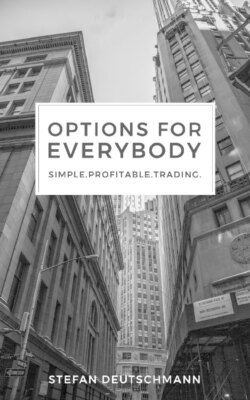Читать книгу Options for everybody - Stefan Deutschmann - Страница 15
На сайте Литреса книга снята с продажи.
Оглавление2.6 Repitition: Understanding Put Options
In the previous section you learned that call options theoretically correspond to 100 long shares for the call holder and 100 short shares for the call seller. A put contract is exactly the opposite. Instead of buying a call up, investors usually buy puts to speculate down, or rather to hedge stock positions! Put options are similar to call options in the sense that they are the theoretical equivalent of 100 shares, but put options let the owner sell the shares at a fixed price for a limited period rather than buy them. So you can buy puts to hedge against falling prices, for example, because you could sell your shares for more than the current price.
If you have a put and the price of a share falls below the strike price you have chosen, you have the right to sell shares at a higher price than the current share price. Many investors regard put contracts as a form of "protection" or insurance against shares already held, as they allow them to secure a selling price for their 100 or more shares. However, this is not free of charge, as the purchase of this insurance costs something, of course. For many people, put options are nothing more than insurance contracts - just like you buy insurance for your car. You pay a premium for this, but you remain hopeful that you will never have to make actual use of this contract.
If the share price rises, the value of the put option decreases. If the stock price at expiration is above the put option, the put contract is worthless because investors could sell shares at a higher price in the market compared to the put strike. Why should anyone sell shares at a lower price than what the market offers? For the same reason, investors would not buy stocks with their call if the call was at a higher strike price than the stock. Just like call options, there are other factors that affect the price of a put option, but from a direct point of view, a put contract works like a call contract.
Just like stock and call options, I can buy or sell a put option. When I buy a put option, I have the right to sell 100 shares at the strike price I have chosen. The put has a real value if the stock price at expiration is below the strike price because it gives me the opportunity to sell shares at a higher price than the stock price. As with long call options, my long put must have a higher value than I paid in advance to be profitable at expiration. This means that we need a directional downward movement to be profitable on expiration with long put options, regardless of where the strike is at the time of purchase.
If a stock is 50 USD and I buy a long put with strike 50 USD for 1 USD, the stock price at maturity must be less than 49 USD in order to make a profit. If the stock price at expiration is 48 USD, my option would have a value of 2 USD and I would make a profit of 1 USD or 100% on the contract because I bought it for 1 USD and sold it for 2 USD. However, if the stock is at USD 50 at expiration, I would lose a premium of USD 1 because the option has no "real" value and investors can now sell stocks in the market at the same price as my strike. We pay an unscheduled value for the right to own the contract, and we have to offset that value against the actual value at expiration. Just as with equity trading when it comes to long calls, I need a stock movement to succeed at expiration and this has to happen before my contract expires.
With the sale of a put we take the opposite side to the example described above. If you sell a put, you are obliged to buy 100 shares at the exercise price you have chosen if the share falls below this price on expiration. If the stock remains unchanged, rises or even falls (but not below the strike) the option is worthless at expiration and you retain the full premium.
If the stock is at 50 USD and I sell the Strike at 30 USD Put for 1 USD and the stock does not move, the put is worthless at expiration and I keep the premium of 1 USD. The loss of the option holder is my profit if I am on the seller's side. In this example, if the stock is at 28 USD at expiration, I would lose USD 1 even though my option is worth USD 2. This is because I have already raised 1 USD to sell the contract, which I can use to my advantage to reduce my losses. This is one of the nice effects of selling premiums - the ability to use the money received to buffer our potential losses. Remember that when we sell options, we are actually betting against the price movement of stocks rather than betting on it. Therefore, we have significantly more profit opportunities because we do not necessarily have to be right about our assumption. The stock has more room to move (also called "wiggle room").
By selling a put, we can again be the insurance agency or casino by betting that the stock price at expiration is NOT at or below our exercise price. If we are right, the premium we received at the beginning is our profit.
